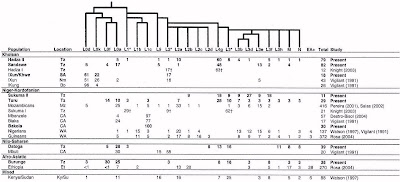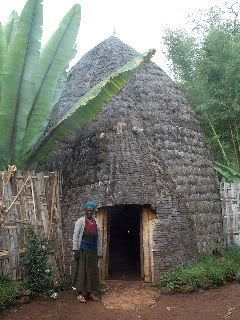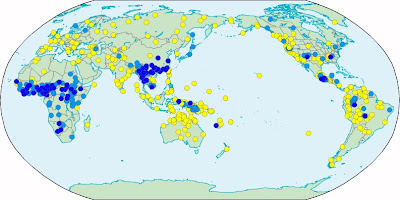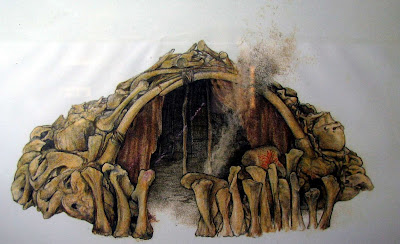This page was compiled for the benefit of those reading the paperback version (available via Amazon.com), from which most of the figures have been omitted. A printer-friendly pdf file can be downloaded from the following link: Figures. (PC users should right-click and select Save link as or Save target as -- Mac users can access the same options by command clicking, using the Apple key.)
To enlarge an image, right click and select "Open link in new tab" -- if you then left click on the image in the new tab, it should expand.
Preface
Figure 0.1 - Wile E. Coyote
Introduction
Introduction
Figure 0.2 - Where Do We Come From, Who Are We, Where Are We Going? (Paul Gauguin)
Chapter Two
Chapter Two
Figure 2.1 African mtDNA (Tishkoff 2007)

Figure 2.3 Y Chromosome DNA (Y Chromosome Consortium 2002)
Figure 5.1 Autosomal DNA in Africa (Tishkoff et al. 2009)
Figure 5.2 Hadza Hut
 Figure 5.3 Hadza Woman
Figure 5.3 Hadza WomanChapter Seven
Figure 7.1 Man with scarification marks -- Africa
Figure 7. 2 Maori Facial Tatoo
Figure 7.3 Tasmanian Woman
Chapter Eight
Figure 8.1 Australian Huts
Figure 8.2 Dorze hut
Figure 8.3 Dorze hut
Figure 8.4 Zulu huts
Figure 8.5 Swazi huts
Figure 8.6 Traditional Zulu Hut
Figure 8.7 Stone “Beehive” Hut -- Bronze Age Ireland
Figure 8.8 “Celtic” Hut (reconstruction) – Wales
Figure 8.9 Traditional Huts – Dani
Figure 8.10 “Beehive” Mud Huts -- Harran, Turkey
Figure 8.11 Syrian Mud Huts
Figure 8.12 Eskimo with dog and igloo
Figure 8.13 Eskimos with different kind of Igloo
Figure 8.14 The Wigglesworth Observatory, under construction
Figure 8.15 Australia -- “Aboriginal hut without its turf covering.”
Figure 8.16 Hadza Hut
Figure 8.17 Bushmen huts
Figure 8.18 Australian huts
Figure 8.19 Tierra del Fuego
Figure 8.20 Framework for Poverty Point hut.
Chapter Nine
Chapter Ten
Figure 10.2 Distribution of M Haplogroups in India (Metspalu et al. 2004)
Figure 10.3 "The segregation of West Eurasian, East Eurasian and South Asian mtDNA pools" (Metspalu et al. 2004)
Figure 10.4 Cosmic microwave background (COBE)
Chapter Eleven
Figure 11.1 Eurasia -- later migrations (Metspalu et al. 2004)
Chapter Twelve
Figure 12.1 Birdbone Pipes from Kostenki (Hitchcock 2009)
Figure 12.2 Mammoth-Bone Hut (reconstruction)
Figure 12.3 Lithuanian Trumpets (Sadie 1984, iii:189)
Figure 12.4 Flute and Horn Ensemble, Chad (Blench 2002)
Chapter Thirteen
Figure 13.1 Indo-European Migrations (Wikipedia)
Figure 13.2 Paleolithic Rock Art -- from Spain (Gimbutas 1991)
Figure 13.3 Images from rock paintings attributed to Bushmen artists -- southern Africa
Figure 13.4 "Polyphony and Complementarity" (Lomax et al. 1968:167)
Chapter Fourteen
Figure 14.3 Joseph Birdsell with adult Australian Pygmy
Chapter Fifteen
Figure 16.1 Phylogenetic Map of Musical Evolution. For details on how it was constructed and how to interpret it, see Appendix B.
Figure 16.2 Siamang Air Sac
Chapter Eighteen
Figure 18.1 (from Xinhuanet, April 5, 2004)
Appendix A
Figure A1: Outline of the Aka Pygmy song, “Makala,” from Kisliuk 1998. Vertical lines and brackets have been added to clarify certain tonal and motivic relationships.
Figure A2: Outline of the Ju/’hoansi Bushmen “Eland Song-little,” from England 1995. Brackets added to clarify certain motivic relationships.
Figure A3: Ju/’hoansi “Eland Song Great,” from England 1967. Vertical lines added to indicate pitch class identities.
Figure A4 - Mbuti Song, "Amabele-o-i-e" -- recorded by Hugh Tracey, transcribed by Victor Grauer
Figure A5 -- Ju/'hoansi Bushmen Song, "The Lion," recorded by Emanuelle Olivier, transcribed by Victor Grauer
Figure A6: Cantometric Profile of Aka Divining Song, "Diye."
Figure A7: Pygmy and Bushmen Profiles Displayed Side by Side
Figure A8 – Modal Profiles for African Pygmies, Bushmen and Farmer-Herders Compared (based on Tables A1-A3)
Appendix B
(To enlarge image, right click and select "Open link in new tab" -- if you then left click on the image in the new tab, it should expand):

Figure B1 -- Phylogenetic Map of Musical Evolution -- Grauer
Figure B2 -- Historical Map of Musical Style -- Grauer
Appendix B
(To enlarge image, right click and select "Open link in new tab" -- if you then left click on the image in the new tab, it should expand):

Figure B1 -- Phylogenetic Map of Musical Evolution -- Grauer
Figure B2 -- Historical Map of Musical Style -- Grauer








































































